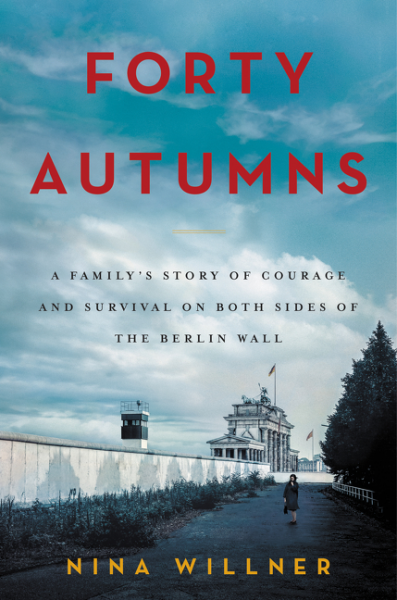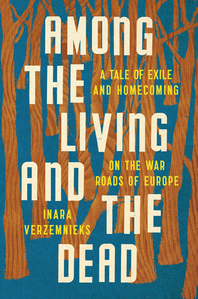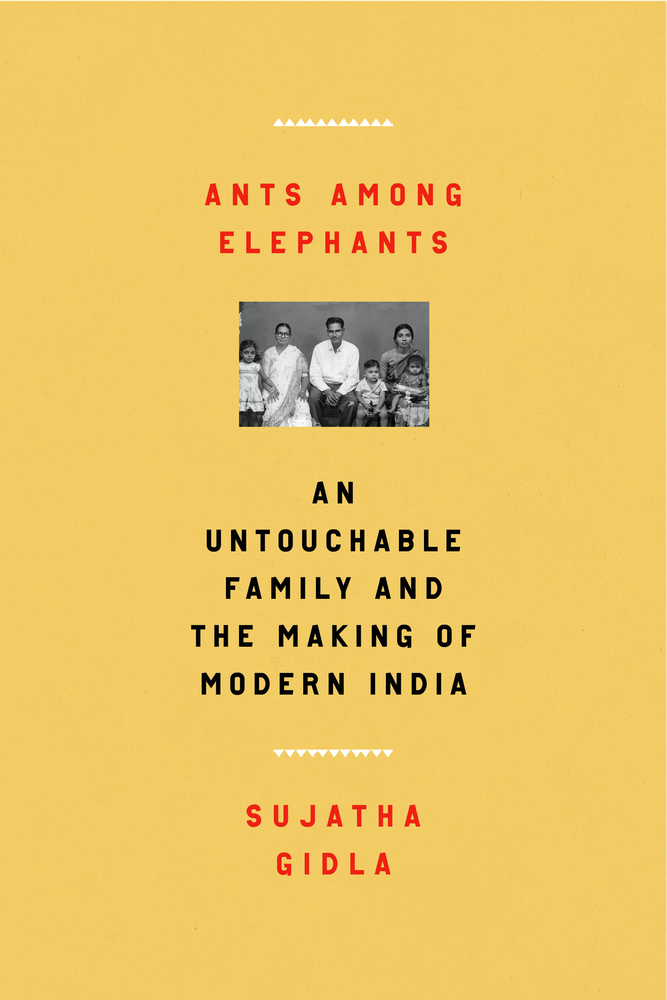
Border police stand next to a sign at the Brandenburg Gate in Berlin June 17, 1986. It says: “Achtung! Sie verlassen jetzt West-Berlin” (Attention, you are leaving West Berlin). (CNS/EPA/Wolfgang Kumm)

Nina Willner examines the rise and fall of East Germany as experienced by one large German family — her own.
As her riveting memoir, Forty Autumns, newly out in paperback, opens in 1945, World War II has ended, and the Americans are driving into the town of Schwaneberg. Willner's grandmother, Oma, is bringing her children out from the cellar where they've been hiding. The future looks good until Oma learns that the Russians, not the Americans, will control their part of Germany. Like other German mothers, Oma has been alone as she cared for, fed and protected her children from the ravages of war.
Her oldest child, Roland, and her husband, Opa, have been serving in Hitler's army. The Third Reich had ordered every able-bodied male over the age of 15 to join the fight for Germany. Roland was only 17. Her husband was 45, a schoolteacher and headmaster — unfit for battle. Oma, in her late 30s, was the mother of five. Hanna, her second oldest child, was 15.
As the narrative develops, Hanna tries to escape to West Germany and succeeds on her third attempt. In a few years, she marries an American lieutenant and leaves for the U.S. where she raises six children. Hanna's parents and siblings, meanwhile, suffer under the totalitarian regime. Hanna tries but fails to connect with her youngest sister, Heidi. The friendship between the two sisters forms a subplot in this carefully written story.
A former U.S. Army intelligence officer who served in Berlin, Willner explains how West Germany flourished after World War II ended. The United States, Britain and France helped the war-torn country to rebuild. Their efforts as well as "the German character," with its hard-work ethic, brought prosperity. Willner herself experienced that prosperity.
But East Germany was a communist state and lacked nearly every accoutrement of modern civilization — like indoor plumbing and electricity. While children in the West were well-nourished, children in the East were not even allowed milk, which was rationed and given only to infants. Churches were closed. Religion and free speech were suppressed — sometimes violently. Those who questioned government policies, as Opa did, were imprisoned and tortured.
Later in the narrative, when Willner's grandmother suffers from diabetes and doctors advise her to eat grapefruit to counteract the disease, there are none to be found. She asks Hanna to send grapefruit, and her daughter does. But the package is intercepted, like most of the mail.
It's no wonder that from 1948 to 1961, East Germany lost one-sixth of its population, as approximately 4 million East Germans defected to the West. Although no one knows how many died while trying to escape, estimates run to more than 1,000 people. Some drowned swimning the Baltic Sea; some were shot; others were killed by booby traps and land mines.
Willner's mother, Hanna, was one of the lucky ones, as was Willner herself. Raised in the U.S., she was able to tell this large-hearted, though chilling, tale.

Although Inara Verzemnieks focuses her story on the past 70 years, her narrative in Among the Living and the Dead is somewhat difficult to follow, partly because she often writes in a stream-of-consciousness style profuse with adjectives and coined words.
Yet Verzemnieks' story is similar to Nina Willner's: Both present history through the eyes of those tyrannized by it. Both center on World War II and feature two sisters — one who stays with her parents enduring extreme deprivation and the other who leaves the homeland for a better life in the U.S.
But the difference between the two memoirs is noteworthy. Willner's book is set in Germany. Verzemnieks' is set in Latvia, considered until recently a "backward" country in Eastern Europe. Willner's family is treated poorly by the Nazis, but Verzemnieks' ancestors have been mistreated from the time of the Vikings on. Invaders took their land and made them second-rate citizens in their own country.
Verzemnieks offers a brief history of the country, beginning with the area as a homeland to Baltic tribes. There were also invasions by Scandinavian countries and later by Russia, Germany, Poland, Lithuania and others who took control of the government, renamed the cities and changed the official language.
Pope Innocent III (1161-1216) even sent the Order of the Brothers of the Sword with instructions to convert the natives — or else. In a papal bull, he described Latvia "as the edge of the known world," which was perhaps his polite way of saying its people were barbarians.
Advertisement
Papal efforts at conversion, though, didn't work as expected. Many people — even baptized Catholics — still retain their pagan beliefs. Verzemnieks' grandmother was a baptized Christian but believed in dreams, signs, ghosts and demons. Evidence of her superstitions exists alongside photographs of herself and her sister in white Communion dresses.
In the late 1850s, serfdom was abolished, and Verzemnieks' great-great-grandfather was finally able to buy a farm. Paradoxically, at the end of World War II, the Russians exiled Verzemnieks' family to Siberia because, according to law, as peasants they were allowed to hold at most 30 hectares of land, not the 33 that they had.
One of the most affecting scenes in this memoir shows Verzemnieks' aunt finding her parents in a cattle car ready to be deported and begging the Soviet guards to let her accompany them to Siberia where she becomes the family breadwinner.
The bitter climate — a glass of milk freezes in five minutes — made it nearly impossible for her elderly parents to function. Spend time in Latvia, Verzemnieks says, and you will discover that "every family's history is cratered with epochs of loss and displacement, sudden chasms of nothing."
Even though Verzemnieks has a tendency to overwrite, she makes a convincing case.

Sujatha Gidla's subject in Ants Among Elephants is the misery of 160 million people living in India who are considered "Untouchables." A subway conductor in New York City, Gidla knows their story firsthand since she lived it.
Although conditions somewhat improved in the second half of the 20th century, Untouchables' lives are far from ideal, as Gidla explains. Many are unable to find jobs because their very presence supposedly pollutes the air breathed by the higher castes. Even their farm animals are not allowed to graze with those owned by higher-ups.
The Untouchables have menial jobs — emptying human waste (among the worst) is one of them. They have little political power and are generally illiterate. Gidla's parents were exceptions. They worked as college lecturers. Gidla's grandfather had fought the system by educating himself and his children.
Despite their education, her family lived in shacks with mud floors, leaking roofs and holes for windows. They often went hungry. Tuberculosis took Gidla's cousin and her grandmother. Gidla herself also had tuberculosis but recovered. Raised in India, but now living in the United States, Gidla (like Willner and Verzemnieks) recounts history through the troubles her family has seen during several generations.
The generations play a role in this highly detailed and complex memoir, which begins with Gidla's great-grandparents who, as part of a nomadic clan, converted to Christianity in the early 20th century. Her great-grandmother preached the Gospel and became known as "the Bible woman." The family was therefore shunned by the other Indian castes and considered Untouchables.
As Gidla explains, tradition has it that Christianity came to India via the apostle Thomas who, in A.D. 52, converted villages on India's western coast. When in A.D. 74 he went to the southeastern city of Mylapore, his message was rejected, and he was murdered.
When Gidla's family converted, Christian tenets were more tolerated partly because missionaries — generally Baptists and Roman Catholics — established schools and hospitals.
Gidla's immediate family, though, had less-than-positive experiences with religious institutions. Her mother taught for a few years in Catholic high schools but was harassed by her principals, possibly because of her low caste. Satyam, her brother, was a communist activist and was traumatized by the clerical sexual abuse prevalent in his Catholic high school.
Gidla's focus on her uncle, also named Satyam, keeps the sprawling narrative somewhat organized, although it is still hard to follow if one isn't familiar with Indian castes. Her brother was forced to drop out of college because of poverty and spent his time in the college library studying literature and reading and writing poetry.
Because he was troubled by the intolerable conditions of the Untouchables, he left his Christian faith, which did little to help the poor, and joined the Communist Party. Forced to leave his wife and children out of concern for their safety, he lived in hiding.
Ultimately, he gave up a normal life to help others and, as Gidla shows, he became almost a Christ-like figure who, although a renowned Indian activist, was little known in the West until now.
[Diane Scharper teaches "The Art of the Memoir" for the Johns Hopkins University Osher Program. She is the author or editor of several memoirs including Reading Lips.]








